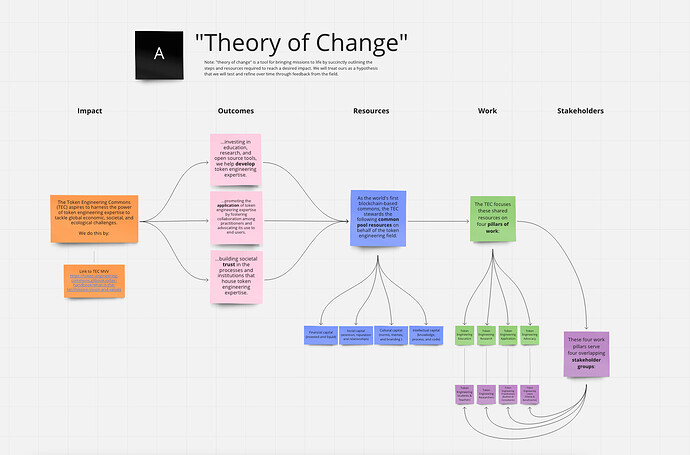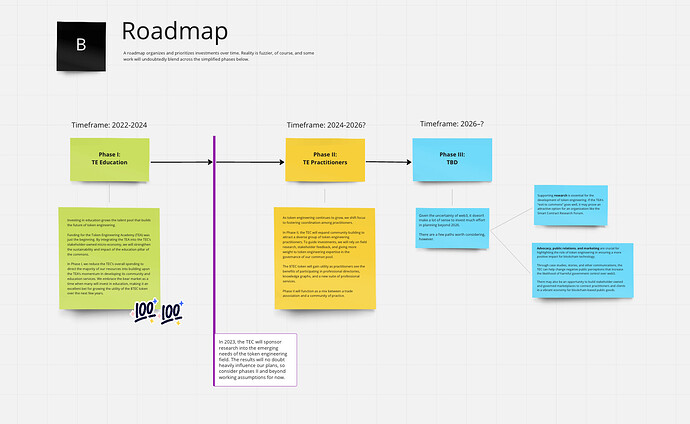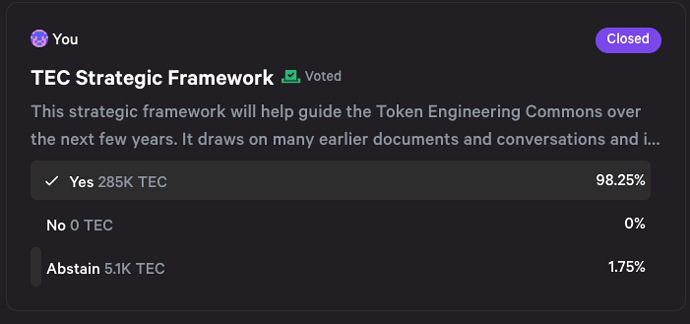Provide as much information as possible about your idea.
This strategic framework will help guide the Token Engineering Commons over the next few years. Most of it should feel familiar, since it draws on many earlier documents and conversations. In this sense, it seeks to transform implicit assumptions into explicit assumptions. This framework is organized as two perspectives or views. The first is a “theory of change,” a logical structure for articulating desired impact and outcomes and the resources, people, and work needed to achieve them. The second view is a chronological ordering, or roadmap.
This framework is intentionally minimalistic – a directional compass heading, rather than detailed plans. This map is not the territory. It is simply a way to balance direction with responsiveness in an emerging field. This framework will evolve over time as our understanding of the terrain improves.
This work has already undergone a fairly extensive advice process with feedback from more than a dozen community members in group and one-on-one sessions. It’s now ready for feedback and a vote by the community. Note that this strategy is intended to work with our existing mission, vision, and values. We may well someday modify that articulation of our work, but that is beyond the scope of this framework.
Theory of Change
Impact:
The Token Engineering Commons (TEC) aspires to harness the power of token engineering expertise to tackle global economic, societal, and ecological challenges. We do this by:
Outcomes:
- investing in education, research, and open source tools, we help develop token engineering expertise.
- promoting the application of token engineering expertise by fostering collaboration among practitioners and advocating its use to end users.
- building societal trust in the processes and institutions that house token engineering expertise.
As the world’s first blockchain-based commons, the TEC stewards the following common pool resources on behalf of the token engineering field:
- Financial capital (invested and liquid)
- Social capital (attention, reputation, and relationships)
- Cultural capital (norms, memes, and branding)
- Intellectual capital (knowledge, process, and code)
The TEC focuses these shared resources on four pillars of work:
- Token Engineering Education
- Token Engineering Research
- Token Engineering Applications
- Token Engineering Advocacy
These four work pillars serve four overlapping stakeholder groups:
- Token Engineering Students & Teachers
- Token Engineering Researchers
- Token Engineering Practitioners (Builders & Consultants)
- Token Engineering Users (Clients & Beneficiaries)
Roadmap
A roadmap organizes and prioritizes investments over time. Reality is fuzzier, of course, and some work will undoubtedly blend across the simplified phases below.
Phase I: TE Education
Time frame: 2022-2024
Investing in education grows the talent pool that builds the future of token engineering. Funding for the Token Engineering Academy (TEA) was just the beginning. By integrating the TEA into the TEC’s stakeholder-owned micro-economy, we will strengthen the sustainability and impact of the education pillar of the commons.
In Phase I, we reduce the TEC’s overall spending to direct the majority of our resources into building upon the TEA’s momentum in developing its community and education services. We embrace the bear market as a time when many will invest in education, making it an excellent bet for growing the utility of the $TEC token over the next few years.
Token Engineering Stakeholder Study
In 2023, the TEC will contribute to research into the emerging needs of the token engineering field. The results will no doubt heavily influence our plans, so consider the following phases just working assumptions for now.
Phase II: TE Practitioners
Time frame: 2024-2026?
As token engineering continues to grow, we shift focus to fostering coordination among practitioners. In Phase II, the TEC will expand community building to attract a diverse group of token engineering practitioners. To guide investments, we will rely on field research, stakeholder feedback, and giving more weight to token engineering expertise in the governance of our common pool. The $TEC token will gain utility as practitioners see the benefits of participating in professional directories, knowledge graphs, and a new suite of professional services. Phase II will function as a mix between a trade association and a community of practice.
Phase III: TBD
Time frame: 2026–?
Given the uncertainty of web3, it doesn’t make a lot of sense to invest much effort in planning beyond 2026. There are a few paths worth considering, however.
- Supporting research is essential for the development of token engineering. If the TEA’s “exit to commons” goes well, it may prove an attractive option for an organization like the Smart Contract Research Forum.
- Advocacy, public relations, and marketing are crucial for highlighting the role of token engineering in ensuring a more positive impact for blockchain technology. Through case studies, stories, and other communications, the TEC can help change negative public perceptions that increase the likelihood of harmful government control over web3. There may also be an opportunity to build stakeholder-owned and governed marketplaces to connect practitioners and clients in a vibrant economy for blockchain-based public goods.
Miro Boards:
This framework was presented to community members for feedback via a Miro board, as part of the initial phases of the advice process.
How is it relevant to the TEC mission, vision and values?
This framework will help focus the TEC on the desired impact, outcomes, work, resources, and timing needed to best fulfill our mission, vision, and values.
Who is going to be affected by what you’re proposing?
All TEC stakeholders could potentially be affected by this framework.
Who has expertise in this topic and could advise your process?
A number of people participated in the initial rounds of the advice process and provided valuable feedback to this framework, including:
@gideonro
@Tamara
@liviade
@Griff
@akrtws
@Juankbell
@bear100
@enti
@natesuits
@BiancaGadelha
@rex
@acidlazzer
@divine_comedian
@JeffEmmett
@JessicaZartler
@mzargham
What type of proposal is this?
Snapshot (cultural)




